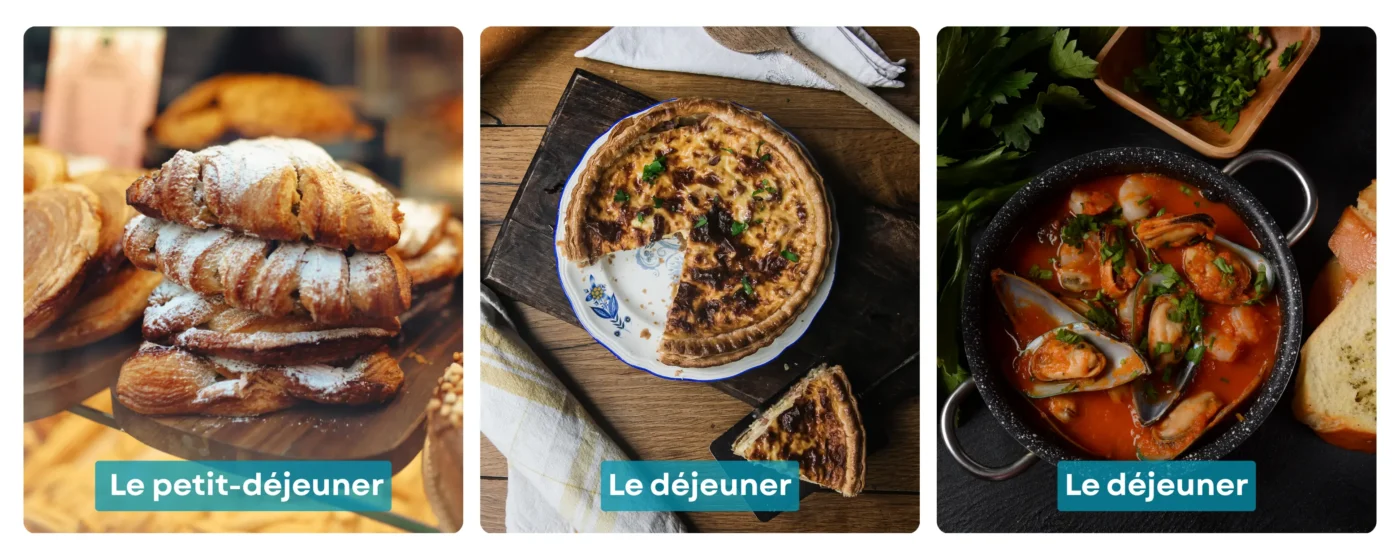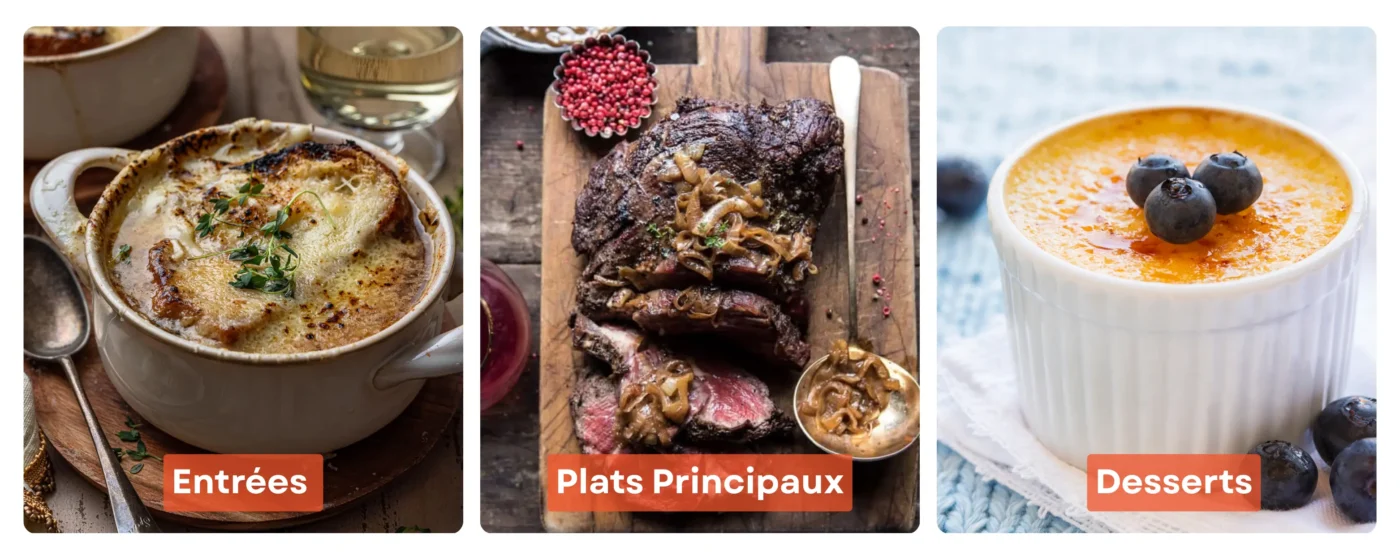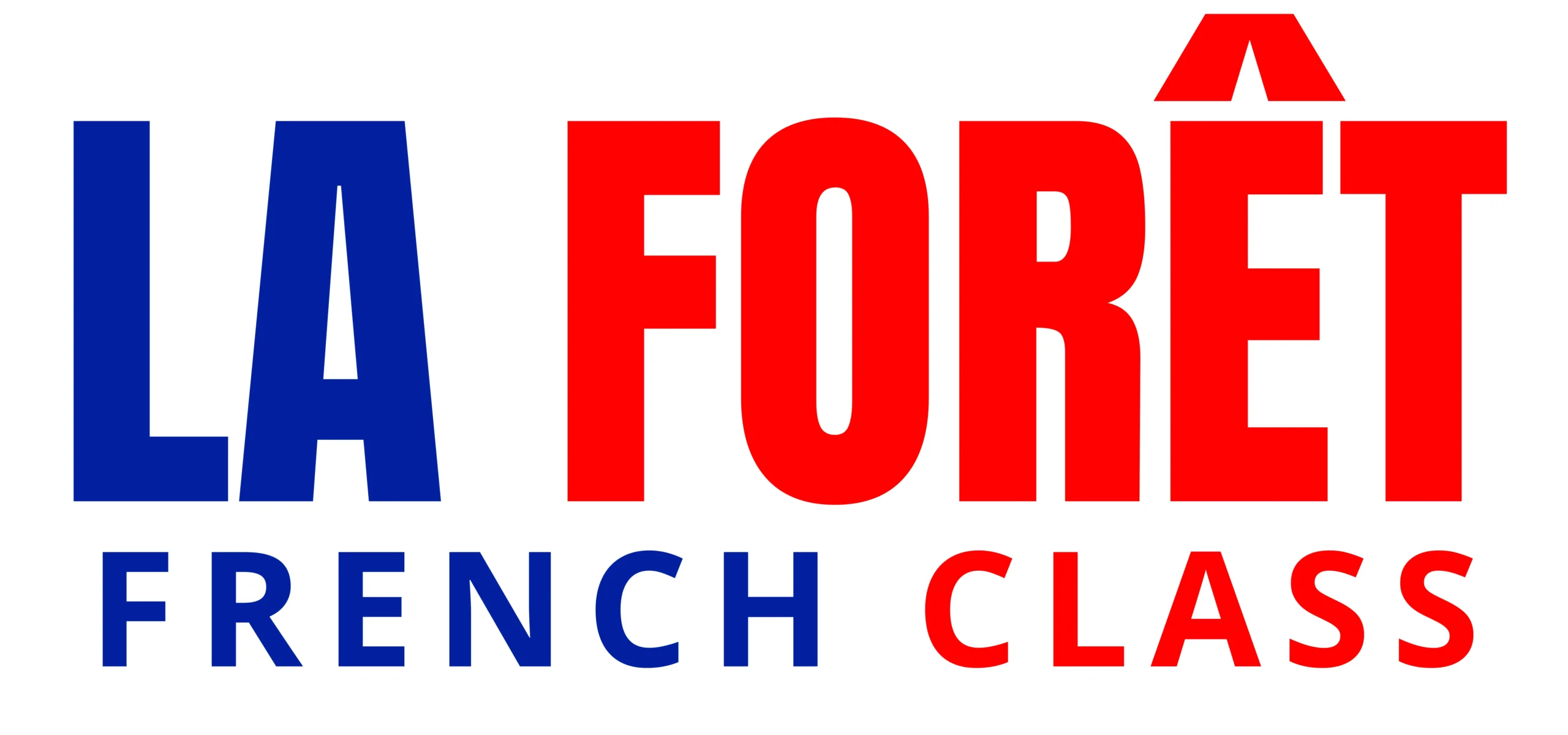Imagine strolling through the charming streets of Paris, the aroma of freshly baked croissants wafting through the air. You spot a quaint bistro, its menu filled with tempting French dishes. But how do you navigate the French culinary experience without a stumble? We know how!
By mastering essential food-related vocabulary and dining etiquette, you can elevate your dining experience in French-speaking countries. From ordering a simple café au lait to indulging in a gourmet meal, knowing the right phrases can make all the difference.
So, let’s embark on a culinary adventure and learn to order food in French like a pro. Bon appétit!
Types of Meals in France


1. Le petit-déjeuner (Breakfast)
A typical French breakfast often includes these key components:
- Croissants: These flaky, buttery pastries are a beloved French breakfast staple. You can order them plain or filled with chocolate, almond paste, or jam.
Exemple: Je voudrais un croissant au chocolat, s’il vous plaît. (I would like a chocolate croissant, please.) - Coffee: The French are passionate about their coffee. You can choose from a variety of options, including:
- Café au lait: Coffee with milk
- Café noir: Black coffee
- Expresso: Espresso
- Cappuccino: Cappuccino
Exemple: Je voudrais un café au lait, s’il vous plaît. (I would like a coffee with milk, please.)
- Bread: Fresh bread, often baguette or pain au chocolat, is another common breakfast item. It’s often enjoyed with butter, jam, or some chocolate spread.
Exemple: Je voudrais une baguette, s’il vous plaît. (I would like a baguette, please.)
2. Le déjeuner (Lunch)
Lunch in France is often considered the main meal of the day, and it’s typically more elaborate than breakfast. A traditional French lunch might consist of several courses: an appetizer (entrée), a main course (plat principal), cheese, and dessert.
Here are some examples for phrases you can use to order your meal:
- Je prendrai le plat du jour. (I’ll have the dish of the day.)
- Je voudrais une salade composée, s’il vous plaît. (I would like a composed salad, please.)
- Pour le plat principal, je choisirai le steak frites. (For the main course, I’ll choose the steak and fries.)
- Je voudrais un café et une tarte aux pommes. (I would like a coffee and an apple tart.)
3. Le dîner (Dinner)
While dinner in France can be quite varied, it’s often lighter than lunch. It might include a starter like a salad or soup, a main course of fish or meat with vegetables, and a dessert.
Here are some example sentences for ordering a French dinner:
- Pour commencer, je prendrai une soupe à l’oignon. (For a starter, I’ll have onion soup.)
- En plat principal, je choisirai le saumon grillé avec des légumes. (For the main course, I’ll choose grilled salmon with vegetables.)
- Pour le dessert, une crème brûlée, s’il vous plaît. (For dessert, a crème brûlée, please.)
- Je voudrais un verre de vin rouge avec mon repas. (I would like a glass of red wine with my meal.)
Navigating Menus in France
Menu Types and Categories


A French menu is often divided into several sections, each representing a course of the meal. Let’s break down the most common sections:
1. Entrées (Starters)
These are the dishes served before the main course. They are often lighter and usually include:
- Salads: A variety of green salads, often with a vinaigrette dressing.
Exemple: Je voudrais une salade composée, s’il vous plaît. (I would like a composed salad, please.)
- Soups: French onion soup, cream of mushroom, or other seasonal soups.
Exemple: Qu’est-ce que vous recommandez comme soupe aujourd’hui? (What soup do you recommend today?)
- Pâtés and terrines: These are cold, savory meat or vegetable spreads.
Exemple: Puis-je avoir une portion de pâté de campagne? (May I have a portion of country pâté?)
2. Plats Principaux (Main Courses)
The main course is the heart of the meal. It typically features:
- Meat: Steak, chicken, lamb, or pork, often served with a sauce and vegetables.
Exemple: Je prendrai le steak frites, s’il vous plaît. (I’ll have the steak and fries, please.)
- Fish: Seafood like salmon, cod, or tuna, prepared in various ways.
Exemple: Qu’est-ce que vous avez comme poisson frais aujourd’hui? (What fresh fish do you have today?)
3. Desserts
Who doesn’t love a sweet ending to their meal. Well, some common French desserts include:
- Crème brûlée: A custard with a caramelized sugar topping.
Exemple: Je voudrais une crème brûlée. (I would like a crème brûlée.)
- Tarte Tatin: An upside-down apple tart.
Exemple: Qu’est-ce que vous avez comme tartes aujourd’hui? (What tarts do you have today?)
- Cheese: In France, cheese is often considered a dessert, and a cheese board can be a meal in itself.
Exemple: Pourriez-vous me conseiller un fromage local? (Could you recommend a local cheese?)
You can also indulge in our insightful blog 20 Classic French Desserts You Must Try to understand more about French Desserts!
4. Drink Options
France is renowned for its wine culture, but it offers a variety of beverages to suit every taste. Here are some common drinks you might encounter:
- Vin (Wine)
- Vin rouge: Red wine
Exemple: Un verre de vin rouge, s’il vous plaît. (A glass of red wine, please.)
- Vin blanc: White wine
Exemple: Un verre de vin blanc, s’il vous plaît. (A glass of white wine, please.)
- Vin rosé: Rosé wine
Exemple: Un verre de vin rosé, s’il vous plaît. (A glass of rosé wine, please.)
- Eau (Water)
Exemples:
- Une carafe d’eau, s’il vous plaît. (A carafe of water, please.)
- Une bouteille d’eau minérale, s’il vous plaît. (A bottle of mineral water, please.)
- Café (Coffee)
- Café: Coffee
Exemple: Un café, s’il vous plaît. (A coffee, please.)
- Café au lait: Coffee with milk
Exemple: Un café au lait, s’il vous plaît. (A coffee with milk, please.)
- Café crème: Coffee with cream
Exemple: Un café crème, s’il vous plaît. (A coffee with cream, please.)
5. Food Options


French cuisine is renowned for its elegance and flavor. Here are a few iconic dishes you might encounter:
- Quiche is a savory tart typically filled with cheese, eggs, and various ingredients like spinach, ham, or vegetables.
Exemple: Je vais prendre la quiche lorraine, s’il vous plaît. (I’ll take the Lorraine quiche, please.)
- Boeuf Bourguignon is a hearty beef stew braised in red wine with vegetables like carrots, onions, and mushrooms.
Exemple: Je voudrais le boeuf bourguignon, s’il vous plaît. (I would like the beef bourguignon, please.)
- Crêpes are thin pancakes that can be enjoyed sweet or savory. Sweet crêpes are filled with Nutella, jam, or fruit. Savory crêpes, on the other hand, are filled with ham, cheese, or vegetables.
Exemples:
- Je vais prendre une crêpe au Nutella. (I’ll take a Nutella crepe.)
- Je voudrais une crêpe complète, s’il vous plaît. (I would like a complete crepe, please.)
Vocab Giving You Trouble? Let’s Fix That!
Join our classes and let our teachers guide you to build a vocabulary that sticks!
How to Order in French?
Here are some essential phrases to help you navigate French restaurants:
1. Basic Phrases:
- Je voudrais… (I would like…)
- S’il vous plaît (Please)
- Merci (Thank you)
- L’addition, s’il vous plaît (The check, please)
- Je vais prendre… (I’ll take…)
- Qu’est-ce que vous recommandez? (What do you recommend?)
2. Specific Requests:
- Sans… (Without…)
Exemple: Un café au lait sans sucre, s’il vous plaît. (A coffee with milk without sugar, please.)
- Avec… (With…)
Exemple: Une salade avec de la vinaigrette, s’il vous plaît. (A salad with vinaigrette, please.)
Allergies and Dietary Restrictions
When dining out in France, it’s important to be able to communicate any allergies or dietary restrictions clearly. Here are some useful phrases:
Allergies:
- Je suis allergique aux noix. (I’m allergic to nuts.)
- Je suis allergique au gluten. (I’m allergic to gluten.)
- Je suis allergique aux fruits de mer. (I’m allergic to seafood.)
- Je suis allergique au lactose. (I’m allergic to lactose.)
Dietary Restrictions:
- Je suis végétarien(ne). (I’m vegetarian.)
- Je suis végétalien(ne). (I’m vegan.)
- Je ne mange pas de viande. (I don’t eat meat.)
- Je ne mange pas de poisson. (I don’t eat fish.)
- Je suis sans gluten. (I’m gluten-free.)
During the Meal
Asking for More
Here are some phrases you can use to ask for more of something:
- Pouvez-vous me donner du pain, s’il vous plaît? (Can you give me some bread, please?)
- Pourriez-vous m’apporter encore un peu de vin, s’il vous plaît? (Could you bring me some more wine, please?)
- Je voudrais encore un peu de fromage, s’il vous plaît. (I would like some more cheese, please.)
Complimenting the Food
To compliment the food, you can use these phrases:
- C’était délicieux! (It was delicious!)
- C’est vraiment très bon! (It’s really very good!)
- Le plat était excellent! (The dish was excellent!)
- Le chef est très talentueux! (The chef is very talented!)
At the End of the Meal
Requesting the Check
To ask for the bill, you can simply say:
L’addition, s’il vous plaît. (The check, please.)
Tipping Etiquette in France
Tipping in France is not as customary as in other countries. While it’s not mandatory, it’s appreciated for exceptional service. A small tip, usually around 5-10% of the bill, can be left for the waiter or waitress. However, it’s important to note that service charges are often included in the bill, especially in restaurants. So, always check your bill carefully. If a service charge is included, a small additional tip is a nice gesture but not strictly necessary!
Types of Restaurants in France
Brasseries: Think of brasseries as the classic French diner, always bustling with activity. They offer a relaxed atmosphere and a diverse menu, from hearty stews to lighter salads. You’ll find them in almost every corner of France, especially in cities like Paris.
Bistros: Bistros are more intimate than brasseries, offering a cozy and often romantic setting. They typically serve traditional French cuisine, such as coq au vin or steak frites. Expect attentive service and a focus on quality ingredients here!
Michelin-Starred Restaurants: For the ultimate culinary experience, you can indulge in a Michelin-starred restaurant. These establishments offer innovative dishes prepared by world-class chefs. Be prepared for a multi-course meal, impeccable service (and a hefty price tag!)
Making Reservations in France
Here are some useful phrases for reserving a table in French:
- Je voudrais réserver une table pour deux. (I’d like to reserve a table for two.)
- Pourriez-vous me réserver une table pour ce soir? (Could you reserve a table for me for tonight?)
- Nous aimerions réserver une table pour quatre personnes. (We would like to reserve a table for four people.)
- Est-ce que vous avez une table de disponible pour demain soir? (Do you have a table available for tomorrow night?)
- Nous aimerions une table près de la fenêtre, s’il vous plaît. (We would like a table near the window, please.)
Other Ways to Eat in France
In many casual eateries, particularly smaller bistros and cafés, it’s often possible to find a table without a reservation, especially during off-peak hours. However, during peak dining times, it’s always a good idea to check if a table is available.
You can use “Y a-t-il une table de libre?” (Is there an available table?) to check if a table is available.
Ordering Takeout
If you prefer to enjoy your meal at home or on the go, ordering takeout is a convenient option. Here are some useful phrases:
- Je voudrais commander à emporter. (I’d like to order takeout.)
- Pouvez-vous me donner la carte, s’il vous plaît? (Can you give me the menu, please?)
- Je vais prendre… (I’ll take…)
- Pour emporter, s’il vous plaît. (For takeout, please.)
Conclusion
Mastering French food vocabulary is your passport to a delightful culinary adventure. From ordering a simple café au lait to savoring a gourmet meal, knowing the right words can elevate your dining experience. For a deeper dive into the French language, consider exploring La Forêt French Class, where you can learn at your own pace and unlock the secrets of French cuisine. Allez-y, are you ready to dive into the French world of ordering food?
Frequently Asked Questions
1. How do you give an order in French?
Ans: To give an order in French, you can use the phrase “Je vais prendre…” (I’ll take…).
Exemple: Je vais prendre le steak frites, s’il vous plaît. (I’ll take the steak and fries, please.)
2. How do you order food formally?
Ans: To order food formally, use phrases like “Je voudrais…” (I would like…) or “Pourriez-vous me servir…” (Could you serve me…).
Exemple: Pourriez-vous me servir une assiette de fruits de mer, s’il vous plaît? (Could you serve me a plate of seafood, please?)
3. How to order a drink in France?
Ans: To order a drink, you can use phrases like “Je voudrais un…” (I would like a…).
Exemple: Je voudrais un verre de vin rouge, s’il vous plaît. (I would like a glass of red wine, please.)
4. How to order a pizza in French?
Ans: To order a pizza, you can say “Je voudrais une pizza…” (I would like a pizza…).
Exemple: Je voudrais une pizza Margherita, s’il vous plaît.(I would like a Margherita pizza, please.)





